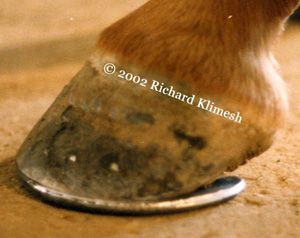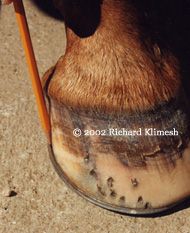Hoof Power


Home | About Us | Articles | Shopping | Contact
Hoof Power | |||
 |  |
Is Your Horse Well-Shod?A Pencil Can Help You Find Out
by Richard Klimesh © 2002 Richard Klimesh © Copyright Information Support
| |||
Shoes that are too short
will not provide adequate support for the limb and can result in under-run heels,
fatigue and permanent damage to the horse's limbs. Unfortunately, one of the most
common ways horses lose front shoes is by stepping on the heels of the shoes and
pulling them off. Consequently, many horseshoers are understandably reluctant
to extend the heels of the shoe (figuring it will save them a return trip to replace
a lost shoe). Speed horses, especially, are likely to be shod with little or no
shoe extending behind the heels of the hoof. Horses with well-formed upright hooves
are better able to tolerate this compromise than are horses with lower angles
or under-run heels. |  | ||
| Expansion
Expansion" can refer to several aspects of a hoof. Here it defines the difference in width between the shoe and the hoof as seen when looking down at the hoof with the foot on the ground. Expansion is the amount of shoe that extends past the sides of the hoof at the heels. The shoe should fit flush with the hoof from the toe around to the quarters (the widest part of the foot) and then be wider than the hoof (when the horse is freshly shod) by at least the thickness of a dime. | |||
|
You can check for expansion by running the point
of the pencil around the edge of the shoe from the quarters to the heels: if there's
no shoe edge for the pencil to ride on, there's no expansion room. Expansion room gives the hoof somewhere to go as it changes shape. With each step a horse takes, the heels of the hoof move outward under the horse's weight. As the foot is lifted, the heels return to their original position. You can usually see evidence of this repetitive heel movement in the form of grooves or shiny areas at the heel area on the hoof surface of a shoe that's been removed. |
 | ||
| Also, because the hoof is cone-shaped, the base of the hoof gets wider as the hoof grows longer. But the steel shoe nailed to the hoof remains its original width. If the shoe is fit too close, with no expansion room at the heels, or if a properly fit shoe is left on too long between shoeings, the hoof wall usually spreads over the edge of the shoe as it grows. When this happens, the reduced bearing surface area of the hoof at the heel is often crushed under the weight of the horse. Then when the hoof is prepared for his next shoeing, the heels have to be trimmed excessively low to get a solid bearing surface. The best shoeing job in the world is worse than worthless if let go too long; letting the hoof grow over the shoe is a direct route down the slippery slope to a Long Toe/Low Heel configuration. Like extending the heels of the shoe, leaving generous expansion room carries a certain amount of risk: a horse could step on the exposed shoe and pull it off. Upright hooves need less expansion room and can be shod fairly close, while more sloping, spread-out hooves need to be shod "full" with plenty of expansion. Also, a wide foot can be shod like a flared foot (they are often one and the same), with side clips to contain the hoof and prevent it from spreading over the shoe. The average shoeing cycle ranges from 5 to 8 weeks. A farrier must determine by experience how much expansion room to leave for each hoof. Just the right amount of expansion will result in the hoof growing to the edge of the shoe but not over it at the end of the shoeing cycle. In fact, this is one of the best ways to determine the length of your horse's shoeing cycle: when the hoof grows flush with the edge of the shoe, it's time for a reset, if the hoof has grown past the shoe you're horse is overdue. | |||
|
| |||
© 2002 Richard Klimesh ©
Copyright Information
Home | About Us | Articles | Shopping | Contact | Site Map | Search
The
information contained on this site is provided for general informational and educational
purposes only.
The suggestions and guidelines should not be used as the sole
answer for a visitor's specific needs.